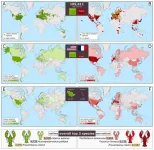(Press-News.org) The future of wireless technology — from charging devices to boosting communication signals — relies on the antennas that transmit electromagnetic waves becoming increasingly versatile, durable and easy to manufacture. Researchers at Drexel University and the University of British Columbia believe kirigami, the ancient Japanese art of cutting and folding paper to create intricate three-dimensional designs, could provide a model for manufacturing the next generation of antennas.
Recently published in the journal Nature Communications, research from the Drexel-UBC team showed how kirigami — a variation of origami — can transform a single sheet of acetate coated with conductive MXene ink into a flexible 3D microwave antenna whose transmission frequency can be adjusted simply by pulling or squeezing to slightly shift its shape.
The proof of concept is significant, according to the researchers, because it represents a new way to quickly and cost-effectively manufacture an antenna by simply coating aqueous MXene ink onto a clear elastic polymer substrate material.
“For wireless technology to support advancements in fields like soft robotics and aerospace, antennas need to be designed for tunable performance and with ease of fabrication,” said Yury Gogotsi, PhD, Distinguished University and Bach Professor in Drexel’s College of Engineering, and a co-author of the research. “Kirigami is a natural model for a manufacturing process, due to the simplicity with which complex 3D forms can be created from a single 2D piece of material.”
Standard microwave antennas can be reconfigured either electronically or by altering their physical shape. However, adding the necessary circuitry to control an antenna electronically can increase its complexity, making the antenna bulkier, more vulnerable to malfunction and more expensive to manufacture. By contrast, the process demonstrated in this joint work leverages physical shape change and can create antennas in a variety of intricate shapes and forms. These antennas are flexible, lightweight and durable, which are crucial factors for their survivability on movable robotics and aerospace components.
To create the test antennas, the researchers first coated a sheet of acetate with a special conductive ink, composed of a titanium carbide MXene, to create frequency-selective patterns. MXene ink is particularly useful in this application because its chemical composition allows it to adhere strongly to the substrate for a durable antenna and can be adjusted to reconfigure the transmission specifications of the antenna.
MXenes are a family of two-dimensional nanomaterials discovered by Drexel researchers in 2011 whose physical and electrochemical properties can be adjusted by slightly altering their chemical composition. MXenes have been widely used in the last decade for applications that require materials with precise physiochemical behavior, such as electromagnetic shielding, biofiltration and energy storage. They have also been explored for telecommunications applications for many years due to their efficiency in transmitting radio waves and their ability to be adjusted to selectively block and allow transmission of electromagnetic waves.
Using kirigami techniques, originally developed in Japan the 4th and 5th centuries A.D., the researchers made a series of parallel cuts in the MXene-coated surface. Pulling at the edges of the sheet triggered an array of square-shaped resonator antennas to spring from its two-dimensional surface. Varying the tension caused the angle of the array to shift — a capability that could be deployed to quickly adjust the communications configuration of the antennas.
The researchers assembled two kirigami antenna arrays for testing. They also created a prototype of a co-planar resonator — a component used in sensors that naturally produces waves of a certain frequency — to showcase the versatility of the approach. In addition to communication applications, resonators and reconfigurable antennas could also be used for strain-sensing, according to the team.
“Frequency selective surfaces, like these antennas, are periodic structures that selectively transmit, reflect, or absorb electromagnetic waves at specific frequencies,” said Mohammad Zarifi, principal research chair, an associate professor at UBC, who helped lead the research. “They have active and/or passive structures and are commonly used in applications such as antennas, radomes, and reflectors to control wave propagation direction in wireless communication at 5G and beyond platforms.”
The kirigami antennas proved effective at transmitting signals in three commonly used microwave frequency bands: 2-4 GHz, 4-8 GHz and 8-12 GHz. Additionally, the team found that shifting the geometry and direction of the substrate could redirect the waves from each resonator.
The frequency produced by the resonator shifted by 400 MHz as its shape was deformed under strain conditions – demonstrating that it could perform effectively as a strain sensor for monitoring the condition of infrastructure and buildings.
According to the team, these findings are the first step toward integrating the components on relevant structures and wireless devices. With kirigami’s myriad forms as their inspiration, the team will now seek to optimize the performance of the antennas by exploring new shapes, substrates and movements.
“Our goal here was to simultaneously improve the adjustability of antenna performance as well as create a simple manufacturing process for new microwave components by incorporating a versatile MXene nanomaterial with kirigami-inspired designs,” said Omid Niksan, PhD, from University of British Columbia, who was an author of the paper. “The next phase of this research will explore new materials and geometries for the antennas.”
END
Ancient 3D paper art, kirigami, could shape modern wireless technology
Researchers from Univ. of British Columbia and Drexel University Use Kirigami to Create Tunable Radio Antennas from MXene Nanomaterials
2024-10-14
ELSE PRESS RELEASES FROM THIS DATE:
Integrating machine learning with statistical methods enhances disease risk prediction models
2024-10-14
Researchers from Peking University have conducted a comprehensive systematic review on the integration of machine learning into statistical methods for disease risk prediction models, shedding light on the potential of such integrated models in clinical diagnosis and screening practices. The study, led by Professor Feng Sun from the Department of Epidemiology and Biostatistics, School of Public Health, Peking University, has been published in Health Data Science.
Disease risk prediction is crucial for early diagnosis and effective clinical decision-making. However, traditional statistical models, such as logistic regression and Cox proportional hazards regression, often ...
Changing watering practices to improve tomato plant health
2024-10-14
Some people believe that talking to your plants makes them thrive. While there’s limited scientific support for sound improving plant health, there’s a growing amount of evidence about the benefits of mechanical stimulation, like touch, wind or rain. Researchers reporting in ACS’ Journal of Agricultural and Food Chemistry examined the impact of watering practices on tomato plants. They found that the size of the water droplets affected plant growth and resistance to pests and pathogens.
Climate change threatens crop production as rising ...
Six proteins implicated in early-onset preeclampsia
2024-10-14
Preeclampsia is a life-threatening pregnancy complication marked by persistent high blood pressure that is even more serious when it occurs early in the first trimester. The exact cause of early-onset preeclampsia is unknown, and it is difficult to predict, prevent and diagnose. Now, in ACS’ Journal of Proteome Research, researchers report on six proteins that could be used as targets to diagnose and treat the condition.
Preeclampsia’s key symptom is high maternal blood pressure, and serious cases can lead to maternal organ failure, low infant birth weight, or maternal or fetal death. ...
Researchers at The University of Texas at San Antonio reveal oversight in AI image recognition tools
2024-10-14
Artificial intelligence can help people process and comprehend large amounts of data with precision, but the modern image recognition platforms and computer vision models that are built into AI frequently overlook an important back-end feature called the alpha channel, which controls the transparency of images, according to a new study.
Researchers at The University of Texas at San Antonio (UTSA) developed a proprietary attack called AlphaDog to study how hackers can exploit this oversight. Their findings are described in a paper written by Guenevere Chen, an assistant professor in the UTSA Department of Electrical and Computer Engineering, and her former ...
World of crayfish™: A web platform for global mapping of freshwater crayfish and pathogens
2024-10-14
Freshwater crayfish, keystone species of aquatic ecosystems, are now at the center of a new tool that promises to revolutionize conservation efforts. World of Crayfish™ (WoC), a newly launched web platform, aims to provide real-time global mapping of freshwater crayfish and their pathogens, offering an invaluable resource for researchers, conservationists, and environmental stakeholders.
Published in PeerJ Life and Environment, the article, World of Crayfish™: A web platform towards real-time global mapping of freshwater crayfish and their pathogens, highlights the urgent need for accurate, up-to-date data on ...
How to make biodiversity credits work: science-based solutions for real conservation gains
2024-10-14
Biodiversity is in crisis. Human activities are driving species extinctions at unprecedented rates, but funding for conservation remains woefully inadequate. To address this gap, the concept of a Biodiversity Credit Market (BCM) has emerged, inspired by carbon credit systems that incentivize conservation and restoration efforts.
However, while the BCM holds promise, it risks falling into the same pitfalls as its carbon counterpart—especially if it fails to implement rigorous science-backed baselines, ...
Qunova becomes first to achieve ‘chemical accuracy’ on commercial quantum computers with its hardware agnostic algorithm
2024-10-14
DAEJEON, South Korea (October 14, 2024) – Qunova Computing, a developer of quantum software applications designed to bring quantum computing to the chemical, pharmaceutical and industrial engineering industries, today announces the results from a series of recent tests performed on three different NISQ era quantum computers, each with a different qubit count. In each demonstration, Qunova’s algorithm was able to produce results with accuracy below the threshold of 1.6 millihartrees required for real-world quantum chemistry applications, a level known as ‘chemical ...
Scientists have successfully bred corals to improve their heat tolerance
2024-10-14
Scientists have successfully bred corals to improve their heat tolerance
A new study has shown that selective breeding can lead to a modest rise in coral heat tolerance.
Led by experts at Newcastle University’s Coralassist Lab, the study documents the world’s first effort to selectively breed adult corals for enhanced heat tolerance, i.e. the ability of adult corals to survive intense marine heatwaves. The breeding effort was a success, showing that it is possible to improve the heat tolerance of adult coral offspring, even in a single generation.
However, the improvement was modest in comparison ...
Adaptability of trees persists after millions of years of climate change
2024-10-14
Seven of the most common forest trees in Europe have been shown to be able to shelter their genetic diversity from major shifts in environmental conditions. This is despite their ranges having shrunk and the number of trees having fallen sharply during ice age cycles. These are the findings of a study by a European consortium including Uppsala University, published in Nature Communications.
“From a biodiversity perspective, this is very positive because these trees are keystone species on which many other species depend,” says Pascal Milesi, Associate Professor of Plant Ecology and Evolution at Uppsala University and first author of the study.
The researchers aimed to investigate ...
Protein involved in balancing DNA replication and restarting found
2024-10-14
A protein that is involved in determining which enzymes cut or unwind DNA during the replication process has been identified in a new study.
In a new paper published in Nature Communications, an international team of researchers have found that the protein USP50 supports the DNA replication process by helping to decide the proper use of nucleases or helicases. These enzymes are implemented during the DNA replication process to promote ongoing replication and where the copying machinery runs into problems ...
LAST 30 PRESS RELEASES:
First Editorial of 2026: Resisting AI slop
Joint ground- and space-based observations reveal Saturn-mass rogue planet
Inheritable genetic variant offers protection against blood cancer risk and progression
Pigs settled Pacific islands alongside early human voyagers
A Coral reef’s daily pulse reshapes microbes in surrounding waters
EAST Tokamak experiments exceed plasma density limit, offering new approach to fusion ignition
Groundbreaking discovery reveals Africa’s oldest cremation pyre and complex ritual practices
First breathing ‘lung-on-chip’ developed using genetically identical cells
How people moved pigs across the Pacific
Interaction of climate change and human activity and its impact on plant diversity in Qinghai-Tibet plateau
From addressing uncertainty to national strategy: an interpretation of Professor Lim Siong Guan’s views
Clinical trials on AI language model use in digestive healthcare
Scientists improve robotic visual–inertial trajectory localization accuracy using cross-modal interaction and selection techniques
Correlation between cancer cachexia and immune-related adverse events in HCC
Human adipose tissue: a new source for functional organoids
Metro lines double as freight highways during off-peak hours, Beijing study shows
Biomedical functions and applications of nanomaterials in tumor diagnosis and treatment: perspectives from ophthalmic oncology
3D imaging unveils how passivation improves perovskite solar cell performance
Enriching framework Al sites in 8-membered rings of Cu-SSZ-39 zeolite to enhance low-temperature ammonia selective catalytic reduction performance
AI-powered RNA drug development: a new frontier in therapeutics
Decoupling the HOR enhancement on PtRu: Dynamically matching interfacial water to reaction coordinates
Sulfur isn’t poisonous when it synergistically acts with phosphine in olefins hydroformylation
URI researchers uncover molecular mechanisms behind speciation in corals
Chitin based carbon aerogel offers a cleaner way to store thermal energy
Tracing hidden sources of nitrate pollution in rapidly changing rural urban landscapes
Viruses on plastic pollution may quietly accelerate the spread of antibiotic resistance
Three UH Rainbow Babies & Children’s faculty elected to prestigious American Pediatric Society
Tunnel resilience models unveiled to aid post-earthquake recovery
Satellite communication systems: the future of 5G/6G connectivity
Space computing power networks: a new frontier for satellite technologies
[Press-News.org] Ancient 3D paper art, kirigami, could shape modern wireless technologyResearchers from Univ. of British Columbia and Drexel University Use Kirigami to Create Tunable Radio Antennas from MXene Nanomaterials






